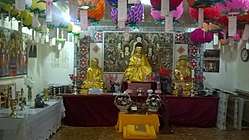Buddhism in Uzbekistan
Buddhism is practiced by about 0.2% of the population of Uzbekistan, according to the US State Department's International Religious Freedom Report 2004. Most are ethnic Koreans. Officially only one Buddhist denomination is registered in Uzbekistan, also there is a Buddhist temple in Tashkent.[1]

History
In the time of the rulers of the Kushan Empire, Buddhism in large scale penetrated into Bactria and Gandhara.[2][3] According to a legend written in Pali two merchants from Bactria, Trapusa and Bahalika, hit the road to meet with the Buddha and became his disciples.[4] Later, they returned to Bactria and built temples in honor of the Buddha.[5][6]
The popularity of Buddhism has been linked to his understanding as an ideology of the urban population. Kanishka the Great confirmed the significantly simplified "way of salvation" of Mahayana Buddhism, which contributed to its mass popularity.[7][8]
After the invasion of ther White Huns, as well as during the Islamic expansion, Buddhism lost its role of widespread and popular religion on the territory of Uzbekistan. By the 13th century it disappeared almost completely as a result of the persecution of infidels during the reign of Khorezm.[9][10]
During the period of the Uzbek Soviet Socialist Republic the rights of local Buddhists were infringed, until the country gained its independence in 1991.
References
- "Summary of Religious Bodies in Uzbekistan". Archived from the original on 2012-09-05. Retrieved 2015-04-29.
- Культура и искусство древнего Узбекистана. Каталог выставки в 2-х томах. М ., 1991.
- Древности южного Узбекистана. Альбом-каталог (на русск., японск., англ. яз.). Токио, 1991.
- Материалы полевых исследований Узбекистанской искусствоведческой экспедиции (Уз ИскЭ). Вып. № 1, 1997; Вып. № 2, 1997; Вып. № 2, Ташкент, 1998.
- Г.Пугаченкова Вклад «УзИскЭ» в познание художественного наследия Узбекистана. // Сб. "Санъатшунослик масалалари — I ". Ташкент, 1998
- Материалы полевых исследований Узбекистанской искусствоведческой экспедиции (Уз ИскЭ). Вып. № 3, 1997; Вып. № 3. Ташкент, 1999
- Ртвеладзе Э. Великий шелковый путь. Ташкент , 1999
- Материалы полевых исследований Узбекистанской искусствоведческой экспедиции (Уз ИскЭ). Вып. № 4, 1997; Вып. № 4. Ташкент, 2000
- Материалы Тохаристанской экспедиции. Вып.1. Ташкент, 2000
- Тermez. - an ancient and modern city at important crossroads. Ташкент , 2001